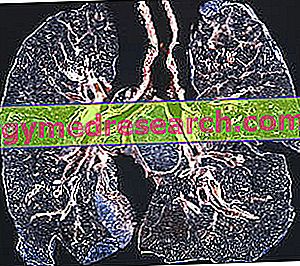Generality
Silicosis is a disease of the lungs that occurs due to prolonged inhalation of crystalline silica dust.

Consequences of silicosis on the lungs. From the site: allaboutlungcancer.net
Belonging to the category of pneumoconiosis, silicosis is a typical occupational disease of ceramists, glassmakers, farmers, miners, those working in cement plants, foundry workers and so on.
The consequences of long exposure to crystalline silica can appear even after many years and consist essentially of damage to the lungs, which causes dyspnea, chest pain, cyanosis, chronic cough and so on.
To diagnose silicosis, doctors use a careful work history and some diagnostic imaging tests.
Silicosis, like other pneumoconioses, is an incurable disease.
Brief reference to pneumoconiosis
Pneumoconiosis is the term used, in medicine, to indicate a group of pulmonary pathologies caused by continuous and long-term inhalation of organic and non-organic powders.
Included in the category of occupational diseases, pneumoconiosis is characterized by a slow and gradual appearance. In fact, the consequences of a pneumoconiosis can become manifest even after 10 to 20 years from when the sick subject was continuously exposed to harmful dust.
Often, pneumoconioses are fatal.
What is silicosis?
Silicosis is a lung disease belonging to the group of pneumoconiosis, caused by prolonged inhalation of crystalline silica dust.
MAIN CONSEQUENCES OF SILICOSIS
Similarly to the more severe pneumoconiosis, silicosis is also responsible for pulmonary granulomatosis and pulmonary fibrosis .
- Pulmonary granulomatosis is a condition marked by the appearance, at the level of the lungs, of granulomas . Granulomas are circumscribed and nodular proliferations of connective tissue, which are formed due to an immune reaction. To cause, in the case of silicosis, the appearance of granulomas - called, in such situations, silicotic granulomas - are the silica particles that, reaching the finest branches of the lungs ( alveoli ), cause inflammation.
- Pulmonary fibrosis, on the other hand, is a disease characterized by hardening and scarring of the lung tissue that surrounds and intervenes between the alveoli. From the histological point of view, the normal lung tissue disappears and is progressively replaced by fibrotic (or cicatricial) tissue.
Granulomatosis and fibrosis reduce the elasticity of the lungs and prevent normal breathing.
PNEUMOCONOSIS, SILICOSIS AND PROFESSIONAL DISEASES
Pneumoconiosis (and therefore also silicosis) are included in the list of so-called occupational diseases (or technopathies ). An occupational disease is a disease that an individual develops when working, due to the presence of harmful factors in the work environment.
Occupational diseases differ from occupational accidents, as they occur in an almost immediate manner, while the former develop over time and gradually.
Attention: those who are diagnosed with pneumoconiosis, due to their past work, can apply for a professional disability.
Epidemiology
Silicosis is the most widespread pneumoconiosis in the world, although in recent years, in countries such as the USA and the United Kingdom, its incidence has dropped considerably.
Today, the areas of the world where the spread of silicosis is still quite high are developing countries and states like China or India, where workers at risk are still not adequately protected.
Data on the number of cases per year and mortality are not precise; surely, they are underestimated, as, as will be seen in the chapter dedicated to symptoms, silicosis is often associated with other deadly conditions.
Causes
Crystalline silica, or more simply silica, is a compound of silicon (Si) contained in many minerals commonly found in nature and which, together with oxygen, represent about 75% of the earth's crust.
They contain silica: granite and sandstone rocks, sand, various minerals in the raw state (such as quartz or plaster), marble, different types of land, slate, etc.
As long as they remain intact or are not processed, these minerals and rocks are harmless. When they undergo drilling, cutting, crushing and / or other types of handling, they produce dust that, if you breathe for a long time and for many years, damages the lung tissue.
The people most at risk of silicosis are:
- Those who work in the mines, because they come into contact daily with minerals and quartz rocks.
- Those who work in the quarries of granite, gravel, sand and sandstone rocks.
- Ceramists and glassmakers
- Farmers
- Steelworks and foundry workers
- Those who work in the naval and railway industry
- Those who work in cement factories

Crystalline silica powder
In October 1996, after extensive research, the IARC (International Agency for Research on Cancer) included crystalline silica among the carcinogens for humans.
TYPES OF SILICOSIS
Based on the duration of exposure to silica dust and the inhaled quantities of the latter, experts distinguish silicosis in:
- Chronic silicosis . Chronic silicosis is the most common form of silicosis. Its onset is the result of long exposure (at least 15-20 years) at low silica levels.
- Accelerated silicosis . Individuals who have inhaled moderate levels of silica dust almost daily and for a period of between 5 and 15 years suffer from accelerated silicosis.
- Acute silicosis . Acute silicosis is the rarest form of silicosis. Those who have inhaled, even for a short time (less than 5 years), very high levels of silica dust are the ones who get it.
From this classification emerges a fundamental concept relating to silicosis: the higher the daily dose of inhaled dusts, the more serious the damage to the lungs and the disease is established quickly.
Symptoms and Complications
To learn more: Silicosis Symptoms
The typical symptoms and signs of silicosis are:
- Sense of oppression and chest pain
- Dyspnea (shortness of breath), both under stress ( dyspnea on exertion ) and at rest ( dyspnea at rest )
- Dry cough
- Chronic bronchitis
- Respiratory problems
- Recurrent fatigue and sense of fatigue
- Cyanosis
- Pulmonary emphysema
- Increased heart rate (tachycardia) and other heart problems
- Bronchial noises
- Temperature
- Small nail fractures
- Body weight loss
Chronic silicosis is a somewhat insidious disease, since its establishment does not always cause immediate and particularly obvious disorders.
Accelerated and acute silicosis, on the other hand, are marked by quite evident and debilitating symptoms. Above all the acute form is distinguished by the severity of dyspnea, dry cough, sense of fatigue and weight loss.
COMPLICATIONS
The complications of silicosis are numerous and are often fatal.
In many cases, chronic obstructive pulmonary disease ( COPD ) and some autoimmune diseases, such as scleroderma, rheumatoid arthritis or systemic lupus erythematosus are associated with the disease .
Moreover, for a reason still unknown, sick individuals are particularly susceptible to tuberculosis (therefore easily infectable by Mycobacterium tuberculosis )
Finally, when pulmonary fibrosis is very severe and / or silicosis is at an advanced stage, other serious pathological conditions can be established, such as pulmonary hypertension, pulmonary heart, respiratory insufficiency and lung cancer (or carcinoma). to the lung ).
Diagnosis
Premise: if an individual has respiratory problems and claims to have performed, for several years, a job considered to be at risk, doctors are expected to suspect an occupational disease and to investigate the exact origin of the disorders.

RX-chest of an individual with silicosis. The blue circles show the presence of silicotic granulomas.
The diagnostic procedure for silicosis requires, first of all, an accurate working history . This means that the doctor will ask the patient for information on the industrial sector in which he has served, the tasks performed, the tasks to which he was assigned and the duration of the work (to get an idea of how long exposure to the silica powders).
For the past medical history (NB: the contribution that family members can make is also important), the doctor
- Analyze the symptoms and signs accused by the patient (dyspnea and dry cough are the most significant manifestations)
- Prescribes diagnostic imaging tests, such as X-ray chest or CT (if the RX-chest is unclear), to learn about the extent of lung damage.
- Evaluate lung function
- Prescribes a lung biopsy
Accurate diagnosis also establishes the severity and type of silicosis in progress. Knowing what the severity and type of silicosis is, allows you to better plan therapy.
Treatment
Unfortunately, silicosis is an incurable disease, the consequences of which, at the level of the lungs, are irreversible. For example, the scar tissue that forms due to pulmonary fibrosis is permanent.
However, although healing is impossible, with an appropriate symptomatic therapy (ie aimed at the symptoms) it is possible to alleviate the disorders and slow down the progression of the disease.
Possible treatments consist of:
- Corticosteroid drugs, to reduce the inflammatory state, and immunosuppressants, when an autoimmune disease has been associated with silicosis.
- Oxygen therapy and respiratory rehabilitation, to address oxygen deficiencies due to impaired lung function.
- Antibiotics, to treat tuberculosis infection (if present)
- Lung transplant, reserved for the most serious cases and for which a compatible donor has been found.
As far as lifestyle is concerned, patients with silicosis are advised to stop smoking immediately (if they are smokers), interrupt their work (if they are still employed in jobs considered at risk), avoid places frequented by smokers and adopt a healthy diet.
Prevention
Reducing the risk of silicosis to zero is difficult, if not impossible. Silica dust production should be kept to a minimum and workers exposed should be completely protected.
Prevention and protection measures, to be adopted in risky workplaces, consist of:
- Provide appropriate protective masks to workers that prevent inhalation of harmful dust.
- Keep levels of toxic dust circulating in the air to a minimum.
- Ventilate the work environment in a suitable and periodic manner.
- Establish a plan for the periodical sanitization of the working environment and of the clothes used by workers (overalls, gloves, masks, etc.).
- Prepare a department (or area), where workers can wash and clean themselves properly from dust residues, before leaving the working environment.
In recent decades, as anticipated, in countries such as the United States or the United Kingdom, mortality from silicosis has been greatly reduced: this has been the result of considerable progress in the field of pneumoconiosis prevention.
Prognosis
Being an incurable disease, silicosis has a negative prognosis.



